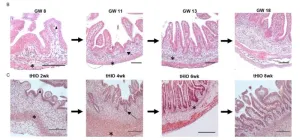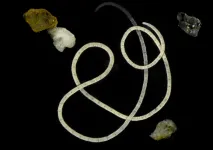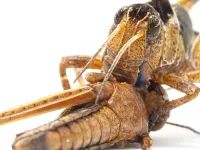(Press-News.org) Developmental biologists have learned a great deal about how the human digestive tract functions through many years of studies involving fish, frogs, and rodents along with detailed explorations of individual human cells. But nothing quite matches the learning that could be achieved from studying actual human organ systems as they form.
Yet for obvious reasons, running experiments on growing human fetuses is both unethical and illegal.
Now a study led by researchers at Cincinnati Children’s, published online April 18, 2023, in the journal Development, reports that lab-grown tissues called organoids accurately mimic key development stages of the human intestine.
“Achieving this step is important because we know that many human conditions cannot be duplicated in animal models, nor can we learn everything we want to know from studying human cells that are not functioning together as a system. Now we have a source of functioning tissue that can be interrogated in many ways without involving any fetal tissue,” says the study’s corresponding author, Michael Helmrath, MD.
Helmrath is the director of surgical research at Cincinnati Children’s and co-director of the Center for Stem Cell and Organoid Medicine (CuSTOM). He has been working for more than a decade to study and improve intestine organoids for use in research and potentially for human transplantation.
In 2010, a team led by James Wells, PhD, at Cincinnati Children’s successfully used induced pluripotent stem cells to develop the world’s first functional human intestinal organoid. Wells, Helmrath and colleagues have been improving upon the model ever since, adding complexity by incorporating both the enteric nervous system and immune cells to reproduce the human intestine.
In their latest study, Helmrath, first author Akaljot Singh, an MD/PhD student, and 11 co-authors show that organoids transplanted into mice (to provide a blood supply and room to grow) follow the same temporal and spatial developmental steps that occur as intestines growing in a human fetus.
The team used RNA sequencing and other technologies to track the formation of specific cell types and key tissue structures grown for four weeks in a dish and then harvested at two, four, six, and eight weeks post-transplant. They show that the organoids in mice mimic human development that occurs from eight to 18 gestational weeks.
“Our findings suggest that tHIOs (transplanted human intestinal organoids) are a proxy for studying the development of the human fetal intestine. They mimic human fetal intestinal development on a morphological level, transcriptional level, and proteomic level,” the study states.
Why are intestine organoids important?
Our intestines do more than help digest our food. They play a central role in our immune response to harmful invaders. They also host populations of commensal (friendly) bacteria and fungi that influence our immune responses and our metabolisms.
Understanding more precisely how and when intestine development goes off-track could shed new light on many conditions, including birth defects, digestive disorders, obesity, and allergy risk. Both healthy intestinal organoids and versions exhibiting disease conditions can serve as improved test platforms to evaluate the safety and effectiveness of virtually any oral medication for any health problem.
Next steps
More research is needed to validate the organoid development model for certain subpopulations of cell types that were difficult to analyze in this study, Helmrath says.
But with the concept established that human organoids growing in mice can serve as a proxy for fetal development, Helmrath predicts a wave of studies to begin using them.
“This study has already identified several cell populations of interest that appear to play roles we did not recognize previously, including cells that appear to help guide muscle contraction, villi formation, and vascular development,” Helmrath says. “In the years to come, we expect tHIOs to support many more discoveries from many labs around the world.”
END
Organoids validated as tool for studying fetal intestine development
Cincinnati Children’s scientists open doors to new wave of disease origin research
2023-05-04
ELSE PRESS RELEASES FROM THIS DATE:
New free-to-read collection shares research on the Southwest Asian and North African region
2023-05-04
Sage has launched a free-to-read collection of research and other resources that explore the Southwest Asian and North African (SWANA) region. Categories in the collection include:
gender role and oppression
governments, laws, and policies
information and media
mental health, healthcare, and medicine
protests, conflicts, and war
refugees, displaced, and stateless people
Readers can access the Southwest Asia and North Africa microsite free for a limited time. END ...
Cleveland Clinic Rare Disease Center recognized as a National Center of Excellence by National Organization for Rare Disorders
2023-05-04
May 4, 2023, Cleveland: Cleveland Clinic has been designated a Rare Disease Center of Excellence by the National Organization for Rare Disorders (NORD). The new Cleveland Clinic Center for Rare Diseases is one of 40 U.S. academic medical centers selected to join the first-of-it-kind national network dedicated to diagnosing, treating and researching all rare diseases.
The NORD Rare Disease Centers of Excellence program provides a much-needed national infrastructure to help accelerate advancements for rare diseases. The network of medical institutions, led by NORD, is designed to improve rare disease patient care by connecting patients to appropriate specialists regardless of disease ...
Adding epigenetic drug to standard chemotherapy was effective in pilot study for T-cell lymphoma
2023-05-04
Nearly 90 percent of patients with an aggressive subtype of non-Hodgkin lymphoma had their cancer go into remission in a small phase 2 clinical trial testing a treatment aimed at making chemotherapy more effective, according to Weill Cornell Medicine and NewYork-Presbyterian investigators.
The clinical trial, whose results were published May 4 in Blood, included 17 patients with a type of blood cancer called peripheral T-cell lymphoma with T-follicular helper phenotype (PTCL-TFH), also known as angioimmunoblastic T-cell lymphoma. Fifteen of them (88.2 percent) had complete ...
What really killed COVID-19 patients: it wasn’t a cytokine storm
2023-05-04
· No evidence of cytokine storm in critically ill patients with COVID-19
· Nearly half of patients with COVID-19 develop a secondary bacterial pneumonia
· Crucial to find and aggressively treat secondary bacterial pneumonia in ICU patients
CHICAGO --- Secondary bacterial infection of the lung (pneumonia) was extremely common in patients with COVID-19, affecting almost half the patients who required support from mechanical ventilation. By applying machine learning to medical record data, scientists at Northwestern University Feinberg School of Medicine found that secondary bacterial pneumonia that does not resolve was a key ...
Many older adults take multiple medications; an updated AGS Beers Criteria® will help ensure they are appropriate
2023-05-04
New York (May 4, 2023) — Today, the American Geriatrics Society (AGS) released the 2023 update to the AGS Beers Criteria® for Potentially Inappropriate Medication Use in Older Adults (DOI: 10.1111/jgs.18372). The AGS Beers Criteria® serves as a comprehensive list of medications that older people should potentially avoid or consider using with caution because they often present unnecessary risks for this population. Given that, according to the National Center for Health Statistics, United States (NCHSUS), more than 88% of older people use at least one prescription and more than 66% use ...
Study presents new clues about the rise of earth’s continents
2023-05-04
Continents are part of what makes Earth uniquely habitable for life among the planets of the solar system, yet surprisingly little is understood about what gave rise to these huge pieces of the planet’s crust and their special properties. New research from Elizabeth Cottrell, research geologist and curator of rocks at the Smithsonian’s National Museum of Natural History, and lead study author Megan Holycross, formerly a Peter Buck Fellow and National Science Foundation Fellow at the museum and now an assistant professor at Cornell University, deepens the understanding of Earth’s crust by testing ...
Converging ocean currents bring floating life and garbage together
2023-05-04
The North Pacific “Garbage Patch” is home to an abundance of floating sea creatures, as well as the plastic waste it has become famous for, according to a study by Rebecca Helm from Georgetown University, US, and colleagues, publishing April 27th in the open access journal PLOS Biology.
There are five main oceanic gyres — vortexes of water where multiple ocean currents meet — of which the North Pacific Subtropical Gyre (NPSG) is the largest. It is also known as the North Pacific “Garbage Patch”, because converging ocean currents have concentrated large amounts ...
Gutless marine worms on a Mediterranean diet: Animals can synthesize phytosterols
2023-05-04
Cholesterol and phytosterol are sterols, fatty compounds essential for many biological processes such as the functioning of cell membranes. Up to now, it has been assumed that phytosterols are characteristic for plants, and cholesterol for animals, and that only plants can make phytosterols, while animals typically make cholesterol. Dolma Michellod, Nicole Dubilier and Manuel Liebeke from the Max Planck Institute for Marine Microbiology in Bremen, Germany, were therefore surprised when they discovered that a small marine worm called Olavius ...
Scientists begin to unravel global role of atmospheric dust in nourishing oceans
2023-05-04
CORVALLIS, Ore. – New research led by an Oregon State University scientist begins to unravel the role dust plays in nourishing global ocean ecosystems while helping regulate atmospheric carbon dioxide levels.
Researchers have long known that phytoplankton – plantlike organisms that live in the upper part of the ocean and are the foundation of the marine food web – rely on dust from land-based sources for key nutrients. But the extent and magnitude of the impact of the dust – ...
Chemical signal protects migratory locusts from cannibalism
2023-05-04
Huge swarms of migratory locusts take on the proportions of natural disasters and threaten the food supply of millions of people, especially in Africa and Asia. As the eighth of the ten biblical plagues, the Book of Moses in the Old Testament already describes how swarms of locusts darkened the sky and ate up everything that grew in the fields and on the trees. Scientists suspect that cannibalism among locusts contributes to their swarming behavior, and swarms therefore constantly move ...
LAST 30 PRESS RELEASES:
Novel endocrine therapy giredestrant improves disease-free survival over standard of care for patients with early-stage breast cancer in phase III lidERA trial
Gen Z views world as "scary place" with growing cynicism about ability to create change
Biosensor performance doubled – New applications possible
Leveraging incomplete remote sensing for forest inventory
Key chemical in dark chocolate may slow down ageing
New 15-minute hepatitis C test paves the way for same-day treatment
Uranus and Neptune might be rock giants
Magnetically actuated soft electrodes for multisite bioelectrical monitoring of ex vivo tissues
FAU engineers decode dementia type using AI and EEG brainwave analysis
Carrier-free peptide–daunorubicin–small interfering RNA nanoassembly for targeted therapy of acute myeloid leukemia
Global Virus Network announces appointment of new board members
Artificial beaver dams show promise in offsetting climate change effects
Could hidden infections be fueling long COVID?
Targeted oxygen for initial resuscitation of preterm infants
Researchers develop models to help diagnose ALS earlier through blood biomarkers
Jeonbuk National University researchers develop novel eco-friendly and photo-switchable smart adhesives
Magnetic ordering induces Jahn–Teller effect in spinel-type compounds
A mitochondrial protein may hold the secret to longevity, new study finds
Study shows how everyday repairs sustain autonomy in a Japanese squat
Ancient manatee relative reveals that sea cows have engineered the Arabian Gulf’s seagrass ecosystems for over 20 million years
Fecal tests reveal active termite attacks
Uterine fibroids linked to elevated heart disease risk
Dual use of cigarettes and vapes can reduce risks of smoking and help smokers quit
New bioelectronics device based on hydrogel- elastomer conductive nanomembranes
More yield through heterosis: IPK research team decodes gene interaction
James Webb telescope reveals spectacular atmospheric escape
ICE-CSIC leads a pioneering study on the feasibility of asteroid mining
Dramatic rise in young people using mental health services
Be careful trusting TikTok for gout advice
A study by the University of Seville links the vanishing of the specific heats at absolute zero with the principle of entropy increase
[Press-News.org] Organoids validated as tool for studying fetal intestine developmentCincinnati Children’s scientists open doors to new wave of disease origin research





